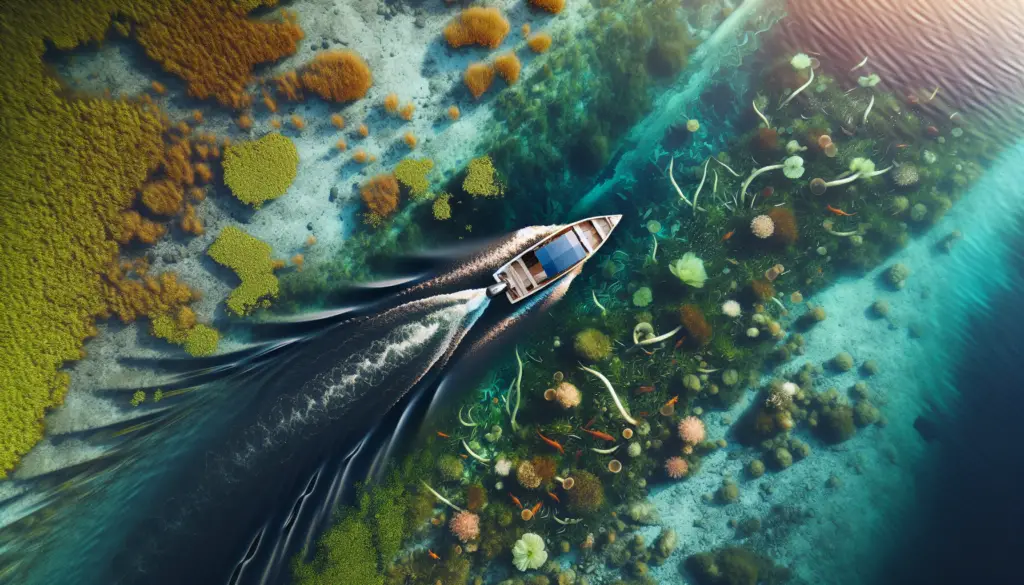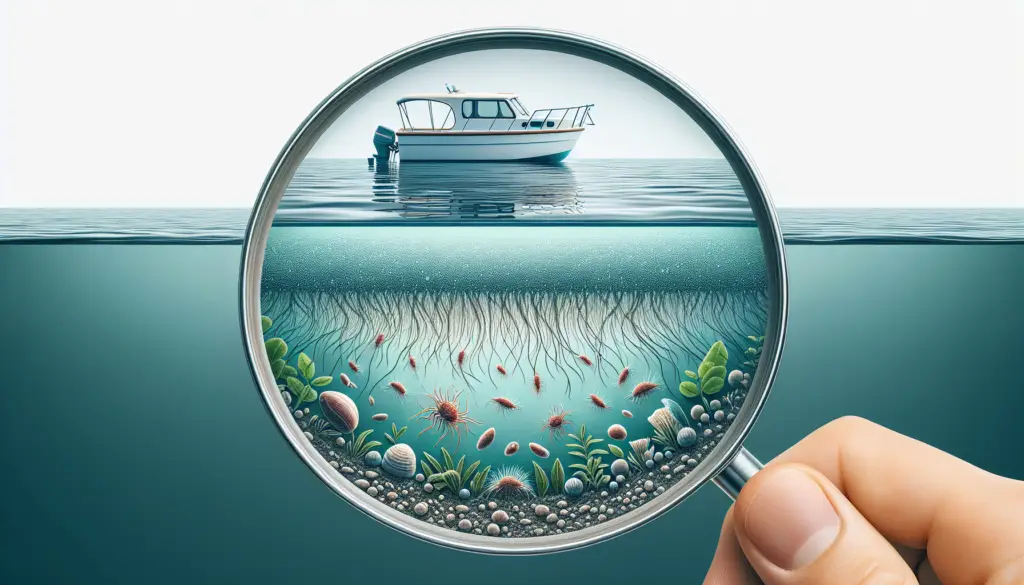Imagine the serenity of a sunny afternoon boating trip being interrupted by the sight of strange aquatic plants tangled around your vessel, or unknown species taking over local fish populations. Unbeknownst to many, these scenarios depict a growing environmental issue – the spread of invasive species through boating. This article tackles the current problems, risks, and possible solutions in mitigating the unintentional transport of non-native species. Who knew your leisurely boat ride could play such a vital role in environmental conservation? It’s time to be aware and make some waves about it!

Understanding Invasive Species
Invasive species can disrupt the natural balance of an aquatic ecosystem. As you navigate through the water bodies in your boat, it’s important to know about these species and how they affect the environment.
Definition of Invasive Species
You might be wondering what exactly qualifies a species as invasive. By definition, an invasive species is a plant, animal, or microorganism that is not native to a particular area, but once they are introduced, they have the potential to spread and cause damage to the local environment, economy and even human health.
Effects of Invasive Species on Aquatic Ecosystems
When an invasive species enters a new body of water, it can quickly overwhelm the existing ecosystem. Invasive species are often able to reproduce rapidly, have few natural predators, and can easily outcompete native species for food and habitats. This can lead to rapid shifts in the aquatic environment, affecting everything from water quality to fish populations.
Common Invasive Species in Water Bodies
Though there are many types of invasive species, some are more commonly encountered in water bodies. Species such as the water hyacinth, zebra mussels, and Asian carp have been particularly problematic in various parts of the world. These species can cause extensive damage by displacing native organisms and altering habitats.
Impact of Boating on Spreading Aquatic Invasive Species
Unbeknownst to you, your boat can act as a vector for the spread of invasive species. As it moves from one water body to another, it may unintentionally carry unseen passengers with it.
How Boats Carry Invasive Species
Invasive species can hitch a ride on your boat in several ways. They can attach themselves to the hull or the motor, hide in the bilge water, or even hitch a ride on any fishing gear or equipment you may have on board. When your boat enters another body of water, the invaders can then detach and make a new home, thus furthering their spread.
The Role of Ballast Water
One of the biggest culprits in spreading invasive aquatic species is ballast water. Ballast water is water that’s taken onboard by ships to maintain stability and balance. It is often taken up in one geographical location and discharged at another, and in the process could hold a variety of foreign species, which when discharged in new waters, establish and wreak havoc therein.
Unintentional Harboring in Hulls and Motors
Your boat doesn’t have to carry ballast water to be a potential threat. The hull and motor of your boat can also unintentionally harbor invasive species. Small species, eggs, larvae, or plants can become lodged in nooks and crannies in the boat’s structure or attached to hard surfaces. When the boat enters new waters, these species can dislodge, thus spreading the invasion further.

Preventative Measures for Boaters
Boaters like you have a crucial role in preventing the spread of invasive species. Simple preventive measures can make a huge difference in maintaining the health of our water bodies.
Regular Inspections of Boat and Equipment
Regular inspections of your boat and equipment are key to identifying invasive species before they can spread. Check your boat’s hull, propeller, anchor, and any equipment that comes into contact with water. Be especially vigilant when moving your boat from one location to another.
Cleaning Procedures to Eliminate Hidden Species
Effective cleaning procedures can help rid your boat of any invasive species. Using high-pressure, hot water can be very effective. Drying the boat and equipment thoroughly before moving to a new location can also help, as many aquatic organisms cannot survive extended periods out of water.
Removing Plants, Animals and Mud from Equipment
It’s also important to physically remove any visible plants, animals and mud from your boat and gear. These materials can harbour invasive species and transport them to new locations. Don’t forget to check places such as propellers, trailers, and fishing gear where these materials can easily be hidden.
Appropriate Disposal of Unwanted Bait
Did you know that even the bait you use for fishing could contribute to the spread of invasive species? This is why it is crucial to dispose of unwanted bait appropriately.
Risks Associated with Releasing Live Bait
It may seem harmless to simply release live bait into the water when you’re done fishing, but this can introduce invasive species. The bait may not be native to the body of water, or it could be unknowingly carrying invasive species.
Correct Methods of Bait Disposal
Instead of releasing unwanted bait into the water, it can either be disposed of in a designated bait-disposal station or in regular waste bins away from the water. Remember, it’s all about preventing any potential invaders from making their way into the water.
Potential Legislation Governing Bait Disposal
Some areas have legislation in place for the control of invasive species, which may include regulations for the disposal of live bait. It’s important to familiarize yourself with any such regulations in your area to avoid unintentionally contributing to the spread of invasive species.

Role of Aquatic Facilities and Marinas in Invasive Species Control
Marinas and other aquatic facilities can play a crucial role in bolstering efforts to control the spread of invasive species. From installing cleaning stations to providing education, there is much they can do.
Installation of Cleaning Stations
One effective way for marinas to prevent the spread of invasive species is by installing cleaning stations. These facilities provide boaters with the resources they need to properly clean their boats and equipment, reducing the risk of spreading invasive species.
Provision of Information on Invasive Species
Another important role of marinas and aquatic facilities is providing information on invasive species. This could include identification guides, information on the impacts of invasive species, and details on how boaters can help prevent their spread.
Enforcing Compliance of Boaters to Cleaning Procedures
Marinas can also help by enforcing compliance with boat cleaning procedures. Making regular inspections and ensuring that boaters are thoroughly cleaning their vessels can greatly help in preventing the spread of invasive species.
Legal Implications and Regulations
Legal regulations are often integral to managing and preventing the spread of invasive species. Non-compliance can carry significant penalties, emphasizing the seriousness of these environmental concerns.
Current Legislation on Invasive Species
There are various laws at the local, national, and international levels that deal with invasive species. Their aim is to prevent the introduction and spread, manage existing populations, and rehabilitate affected ecosystems. It’s important to be aware of any relevant laws in your area.
Boating Guidelines to Prevent Spread
There are specific boating-related regulations designed to help prevent the spread of invasive species. These can include mandatory boat inspections, cleaning protocols, and guidelines for equipment use.
Penalties for Non-compliance with Laws and Regulations
If you fail to comply with laws and regulations related to invasive species, you could face serious consequences. These can include fines, restrictions on boating privileges, or even jail time in extreme cases.

Public Awareness and Education
Education is a vital component in the fight against the spread of invasive species. The more individuals understand about the issue, the more they can do to help prevent the spread of these damaging organisms.
Importance of Public Awareness Campaigns
Public awareness campaigns play a crucial role in educating the general public about invasive species. They can inform people about what invasive species are, why they are a problem, and how they can play a part in preventing their spread.
Educational Programs for Children and Adults
Both children and adults can benefit from educational programs about invasive species. These can take many forms, from school-based programs to adult workshops. The objective is to make everyone aware of the impact they can have on our environment.
Role of Media in Spreading Awareness
The media is a powerful tool in spreading awareness about invasive species. Through news stories, documentaries, and social media, the issue can be brought to the forefront of public attention, helping to foster a culture of responsibility and protection of our natural water bodies.
Collaboration with Environmental Organizations
Teaming up with environmental organizations can also be fruitful in this battle. Such organizations possess the knowledge, resources, and expertise needed to combat the spread of invasive species effectively.
Role of NGOs in Fighting Invasive Species
Non-Governmental Organizations (NGOs) can play a vital role in combating invasive species. This includes conducting research, implementing management strategies, running public awareness campaigns, and advocating for stronger legislation.
How Boating Community can Partner with Environmental Groups
The boating community has a unique opportunity to partner with these organizations to further their efforts. This could include participating in clean-ups, contributing to citizen science initiatives, or even sponsoring educational events.
Success Stories of NGO-Boating Community Partnerships
There are many stories of successful partnerships between the boating community and NGOs. These partnerships have resulted in substantial strides in controlling and preventing the spread of invasive species in various water bodies around the globe.
Research and Innovations
Scientific research and innovative technologies are continually being developed. These often offer promising new ways to detect and manage invasive species.
Emerging Technologies for Early Detection
New technologies are being developed to detect invasive species at early stages. For instance, environmental DNA (eDNA) sampling can detect the presence of an invasive species in a water body before it has become established.
Eco-friendly Boating Materials and Design
eco-friendly boat designs and materials that make it harder for species to attach can help prevent the spread of invasive species. Future innovations in this area could give boaters more choices for environmentally friendly boats that are less likely to inadvertently spread species.
Scientific Research on Invasive Species Management
Ongoing scientists are investigating a variety of methods for managing invasive species, including biological controls, chemical treatments, and environmental manipulations. This research will continue to inspire new strategies for fighting the spread of invasive species.
Global Efforts to Reduce Spread of Invasive Species via Boating
Invasive species are not confined within any geographical boundaries, hence the control and management of invasive species is a global problem that needs a global solution.
International Protocols and Treaties
Various international protocols and treaties aim to prevent the international transport and spread of invasive species. Countries worldwide are encouraged to implement and enforce these treaties to maintain their biodiversity and protect their water bodies.
Cross-border Collaboration and Reporting
collaboration and open reporting between nations are also crucial for controlling the spread of invasive species. Sharing information about invasive species sightings or outbreaks can help countries to take swift action and prevent further spread.
Case Studies of Successful Reduction in Invasive Species Spread Through Boating
Many successful measures have been taken to reduce the spread of invasive species worldwide. These case studies provide valuable lessons and strategies that can be replicated in other locations.
As a boater, you have a crucial role to play in protecting our aquatic ecosystems from the threat of invasive species. By staying informed, taking simple precautions, and working with authorities and organizations, you can help to preserve our beautiful water bodies for future generations.

